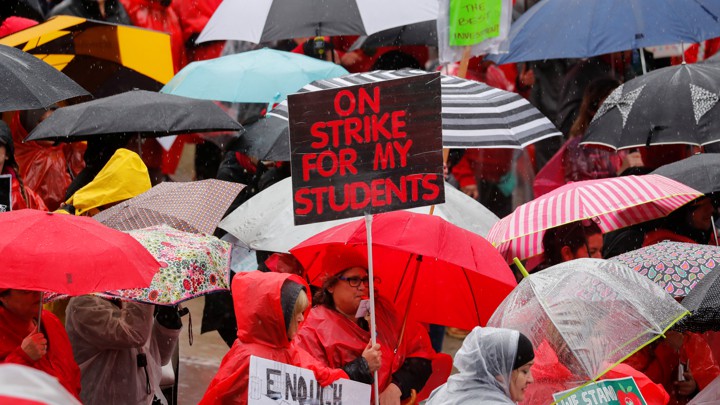America’s Teachers Are Furious

These protests follow many others around the country. Last February, roughly 20,000 teachers in all of West Virginia’s 55 counties walked out. A month or so later, teachers in Oklahoma boycotted their classrooms; Kentucky’s educators staged their own strike that same day in early April, as did their counterparts in Arizona a few weeks later, picketing for a week. Later, a one-day rally by teachers in North Carolina forced numerous school districts to cancel classes. And last month, unionized educators in one of Chicago’s largest charter networks walked off the job—the first strike of its kind in the country’s history.
Even that wave pales in comparison with today’s. Inconsistencies in the Bureau of Labor Statistics’ data-collection methods make it tricky to compare the two periods in quantitative terms. What’s clear, though, is that the the eight major 2018 strikes—including the four high-profile statewide walkouts—involved a total of more than 379,000 teachers and school staff. Taking into account the current L.A. strike—which is poised to end after Tuesday, pending teachers’ ratification of their union’s newly inked agreement with the district—brings the tally to at least 409,000. The four major teachers’ strikes of 1968, by contrast, involved some 107,000 educators total, according to a Bureau of Labor Statistics analysis.
If nothing else, education-policy scholars, legal analysts, and labor experts tell me this wave is unprecedented in the terms that matter most: the stakes, the sentiments, the long-term implications. The walkout in Los Angeles is distinct from its red-state predecessors of 2018 in many regards—its participants are effectively facing off against a Democratic-controlled school district and state, for example, and a plurality of them are Latino, including many whose activist roots run deep. Still, the impact of this strike, which has shut down the country’s second-largest school district for more than a week, amounts to much more than a disruption to classes for nearly 500,000 students. It could go as far as helping to solidify this sequence of strikes as a pivotal moment in a 21st-century labor movement that is characterized by its radicalism and sense of collective action, suggests Charlotte Garden, a professor at Seattle University School of Law who studies labor.
Read: The unique racial dynamics of the L.A. teachers’ strike
Back when teachers’ unions first rose to prominence in the early 20th century, the organizations were seen as white-collar guilds tasked with serving educators’ professional needs, Garden says. They were conceived as distinct from, say, the steelworker and coal-miner unions, which were known for their activist bent and narrative of class struggle. But in recent years, many teachers’ unions have been modifying their brand and their explicit mission, placing emphasis on issues beyond educators’ own pocketbooks. In last year’s West Virginia strike, for example, teachers decried students’ limited access to quality instruction; in Oklahoma, their targets were outdated textbooks and dilapidated facilities; in Los Angeles, they condemned the paucity of counselors and classrooms packed like sardines.
This broader, more public-minded approach has its roots in 2012, and in a city wellversed in teachers’ strikes: Chicago. The timing was hardly auspicious for an uprising: American taxpayers, whose support for unions in general had been declining, had started to see public-sector unions as incompatible with their interests as taxpayers; politicians from both parties were starting to place restrictions on such organizations. The impulse for many political leaders in the Windy City was thus to dismiss the walkout as unnecessary and superficial.
Yet, as Erik Loomis writes in his recent book on the history of strikes in the United States, money was an afterthought for Chicago’s teachers. Instead, echoing a landmark report their union had published earlier that year outlining the changes the students needed to thrive, teachers demanded more and better training for serving specific populations, as well as fair evaluations designed with kids’ success in mind; they called for air conditioning in their sweltering classrooms and lower limits on how many students could be placed into those classrooms.
The teachers wanted, Loomis writes, “to work and live with human dignity,” an objective the teachers’ union framed as inseparable from a similar sense of dignity among children both in and outside of school. After a week of boycotting their classrooms, the teachers secured some concessions from the district—including a carefully crafted evaluation system that relies partly on student test scores, textbooks for all kids on the first day of school, and a more holistic curriculum with a greater investment in extracurriculars such as art.
Since then, teachers’ strikes have continued to focus even more on these beyond-the-pocketbook issues. One reason is simply that the quality of the country’s public schools is, in certain places, terrible. The Great Recession ushered in an era of austerity measures that significantly hamstrung public schools across the country; in a handful of red states, school spending never returned to pre-2008 levels. Additionally, schools have been resegregating, contributing to growing race- and income-based disparities in achievement, and standardized testing, which proliferated following the No Child Left Behind Act signed into law by George W. Bush in 2002, continues to dictate the way many schools are measured and run.
Even so, critics suggest that self-interest is nevertheless what’s driving teachers’ unions to the picket lines. Jeanne Allen, the founder and director of the Center for Education Reform, a pro-charter-school organization, says that following Janus, “teachers are desperately afraid that if they have to go out and recruit members and convince them that [the unions] are worthwhile,” the unions won’t be able to collect the fees needed to sustain themselves.
As evidence, Allen cites the collective-bargaining proposal submitted by the L.A. teachers’ union earlier this month: It stipulated that the district would have to provide the union with the contact information of every LAUSD employee, for example, and restrict the number of activities for which schools can request teachers’ participation rather than leaving that up to individual campuses. In other words, the union may be attempting to keep a tight rein on staff who in a post-Janusworld may choose to distance themselves from the union. The union is seeking to “micromanage the district,” Allen argues, by gaining more control over decisions that individual schools should have the power to make.
Read: Is this the end of public-sector unions in America?
Teachers concede that the walkout had been in the works for some time, but their motives, they argue, go beyond self-interest and beyond strengthening the union for the union’s sake. “People are pissed about the conditions in L.A.” says Pedro Noguera, a distinguished professor of education at UCLA whose research as a sociologist focuses on the impact of race and class on schools. By “conditions” he means the class sizes (some are as large as 46 students, exceeding the 39-pupil limit stipulated by teachers’ last contract), the lack of support staff (each high-school counselor in the district has an average caseload of nearly 400 students), and the rapid growth of charter schools (at 224, Los Angeles has more such institutions than any other U.S. city, and a number of studies, at least one of them union-funded, have found that the charter-school sector siphons hundreds of millions of dollars out of the union every year). “All those things come together to make people very angry,” Noguera said.
“We’ve been in this fight since before Janus … We believe in this stuff,” says Arlene Inouye, one of the union’s chief negotiators and a former public-school educator, pointing to the overall decline in classroom conditions and highlighting the union’s leadership overhaul four years ago. In an interview, John Rogers, an education-policy professor at UCLA,suggested that more teachers in L.A.—and across the country—are starting to see themselves as “guardians of democracy.” While the legislative results of last year’s strikes have been mixed, various polls showed rising support nationally for teacher-salary hikes, strikes, and school-funding increases.
Still, even if L.A.’s teachers have broad support from the public, it remains unclear how their demands will be funded; as of Tuesday morning local time, details on the tentative agreement hadn’t been released. While union officials and some analysts pointed to the district’s nearly $2 billion in reserves, LAUSD maintained that the remaining money it has is already being spent or has been committed to critical expenditures, including pay raises and staffing increases that partly heed teachers’ demands. When we spoke last week, UCLA’s Noguera emphasized that he sympathizes with the teachers’ concerns and their impulse to walk out—but that he recognizes the district’s fiscal dilemma, too. Because the school district receives its per-pupil funding from the state, every day of the strike—with the declining rates of kids showing up to school—comes with an immense deduction in those public dollars. As of Friday, according to district data, LAUSD had lost close to $125 million in gross revenue. “If you’re really trying to fund public education, and the strike weakens the system,” Noguera suggests, “then you’re actually going to be weakening public education.”
We want to hear what you think about this article. Submit a letter to the editor or write to letters@theatlantic.com.








Follow Us!